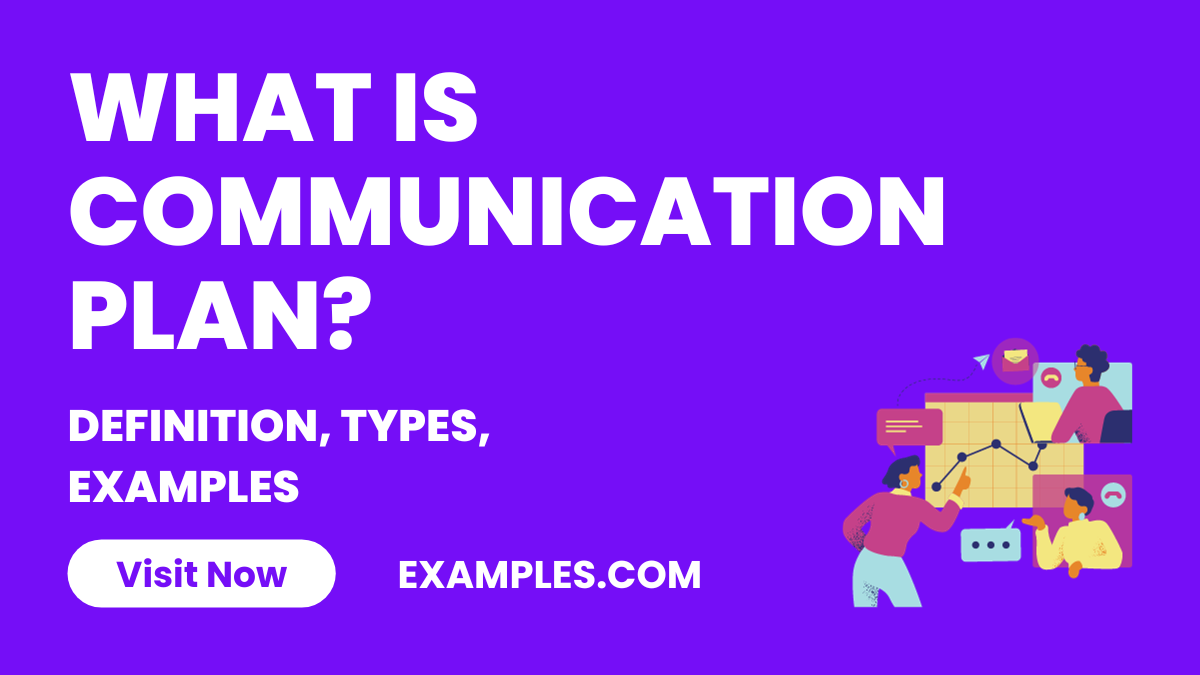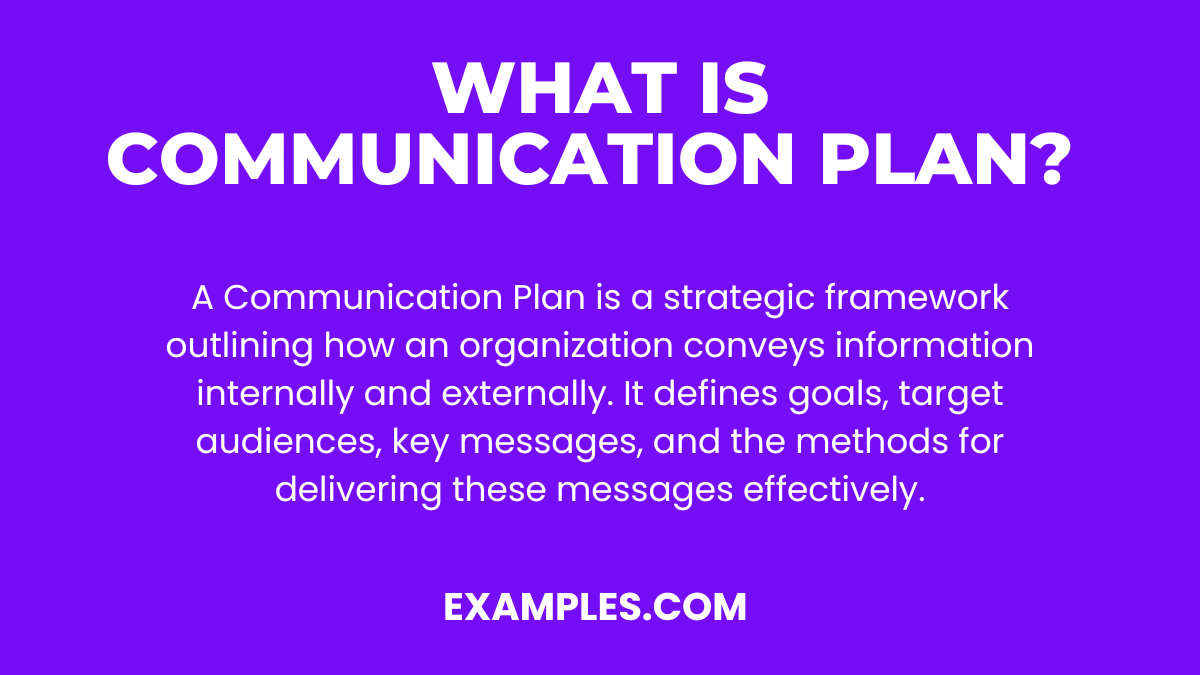What is Communication Plan? – Definition, Types, Examples
A Communication Plan is an essential roadmap for any organization’s success, outlining the strategy for conveying key messages to various stakeholders. This comprehensive guide, enriched with Communication Examples, delves into different types of communication plans, each tailored to meet specific objectives. With real-life examples, it illustrates effective techniques and tactics used in crafting messages, choosing appropriate channels, and measuring impact. Understanding these examples is pivotal in developing a plan that not only reaches but also resonates with the intended audience, fostering engagement and achieving organizational goals.
What is Communication Plan? – Definition
A Communication Plan is a strategic document that outlines how to effectively convey messages to the intended audience. It guides the process of sharing information within an organization or between an organization and its publics. The plan typically includes the purpose of the communication, the audience, the message to be conveyed, the channels for disseminating the information, and the timeframe. It’s essential for ensuring that communication is clear, consistent, and aligned with organizational goals.
Examples of Communication Plan
Creating a communication plan involves strategizing how to effectively share information within an organization or with its audience. This includes identifying the message, choosing appropriate channels, and considering the audience’s needs. Here are 10 unique examples of communication plans, each showcasing different scenarios:
- Product Launch Plan: Outlines communication strategies for introducing a new product to the market.
- Crisis Management Plan: Details how to communicate during an emergency or unexpected situation.
- Internal Change Management: Guides communication within an organization during major changes like leadership shifts.
- Event Promotion Plan: Focuses on communicating about an upcoming event.
- Stakeholder Engagement Plan: Tailored for interacting with key stakeholders.
- Employee Engagement Plan: Aims at improving internal communication with employees.
- Customer Feedback Plan: Centers on gathering and responding to customer feedback.
- Health Communication Campaign: Designed for public health awareness campaigns.
- Community Relations Plan: Focuses on building relationships with the community.
- Marketing Communication Plan: Outlines strategies for advertising and promotions
Types of Communication Plans:
Types of Communication Plans encompass various strategies tailored to specific organizational needs. These include:
- Internal Communication Plans: Focus on enhancing communication within an organization to boost employee engagement and productivity.
- Crisis Communication Plans: Designed for managing communication effectively in emergency or crisis situations.
- Stakeholder Communication Plans: Aimed at engaging with key stakeholders, including investors, partners, and customers.
- Project Communication Plans: Essential for ensuring all project stakeholders are informed and aligned throughout a project’s lifecycle.
- Corporate Communication Plans: Encompass a broad range of internal and external communication strategies to support the organization’s overall objectives.
Elements of Communication Plan
The elements of a Communication Plan are crucial for successful information dissemination. Key elements include identifying objectives, targeting audiences, defining key messages, selecting appropriate communication channels, and establishing a timeline. Additionally, assigning roles and responsibilities, budget considerations, and evaluating the effectiveness of the communication strategy are integral parts of a comprehensive plan. These components work together to ensure that the communication is clear, effective, and aligns with the overall goals of the organization.
Communication Plan for Change Management: A Communication Plan for Change Management is crucial for guiding organizations through transitions, focusing on keeping stakeholders informed and engaged. It addresses how changes will be communicated, ensuring transparency and understanding among employees.
Strategic Communication Plan: A strategic communication plan outlines how an organization communicates its mission, vision, and goals. It’s a long-term strategy, integrating marketing, public relations, and internal communication.
Effective Communication Plan: An effective Communication plan ensures clear, concise, and purposeful communication. It’s tailored to reach and engage the target audience, delivering impactful messages.
School Communication Plan: This School Communication Plan focuses on fostering communication between schools, students, parents, and the community. It’s essential for sharing information about educational programs, policies, and student progress.
Communication Improvement Plan: A Communication Improvement Plan Designed to enhance existing communication methods, this plan identifies areas for improvement and strategies to strengthen communication effectiveness.
Elements of Communication Plan: Essential elements Communication Plan include defining objectives, identifying target audiences, crafting key messages, choosing appropriate channels, and establishing evaluation methods.
External Communication Plan: A External Communication Plan Focuses on how an organization communicates with external stakeholders, including the media, public, and partners. It’s key for maintaining a positive public image.
Simple Communication Plan: A Simple Communication Plan straightforward plan, emphasizing clarity and ease of implementation. Ideal for smaller teams or projects with limited resources.
Communication Skills Treatment Plan: This Communication Skills Treatment plan is used in therapeutic settings to develop and enhance communication skills, often addressing specific speech or language challenges.
Comprehensive Communication Plan: A Comprehensive Communication plan covering all aspects of an organization’s communication. It includes internal and external strategies, crisis communication, and stakeholder engagement.
Communication Skills Lesson Plan: A Communication Skills Lesson Plan Designed for educational settings, this plan includes activities and lessons to teach effective communication skills to students.
Product Launch Communication Plan: A Product Launch Communication Plan Tailored for introducing new products to the market. It outlines strategies for creating buzz and informing potential customers about the new offering.
A communication plan is vital for any project or organization, focusing on key components to ensure effective information dissemination. At its core, it includes clear objectives outlining what the communication aims to achieve, and a target audience to specify who the message is for. The plan details the key messages to be conveyed, ensuring consistency and relevance. It also encompasses the choice of appropriate channels and tools for message delivery, be it emails, social media, or meetings. Additionally, a timeline for communication activities provides structure, while a feedback mechanism allows for continual improvement. Lastly, roles and responsibilities are assigned to ensure accountability and efficient execution of the communication strategy.
The article Building a Communication Plan: Every Piece Matters from DINFOS Pavilion delves into creating an effective communication plan strategy through research, action planning, and evaluation. It details a practical scenario at a Navy base, highlighting the importance of understanding the problem, setting clear goals and objectives, identifying key publics, and crafting tailored messages. The plan emphasizes strategies and tactics, budget considerations, and the necessity of regular evaluation to ensure the desired impact. This resource is a comprehensive guide for anyone looking to develop a cohesive and impactful communication plan.




